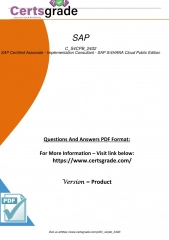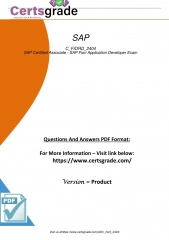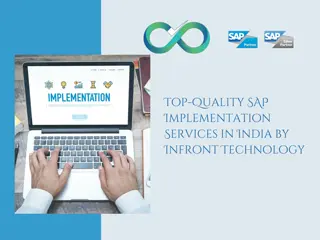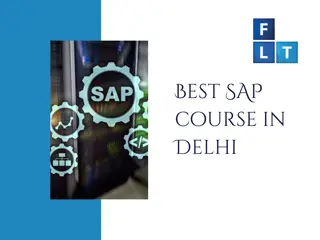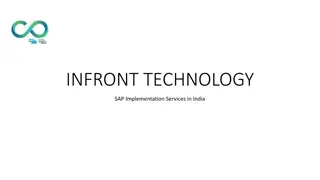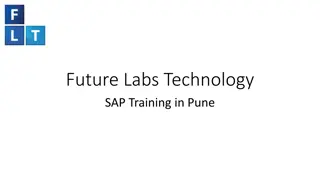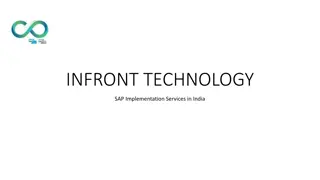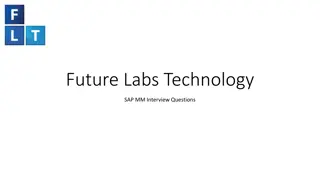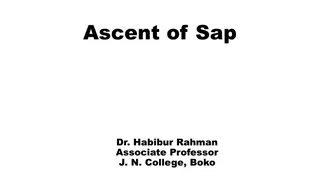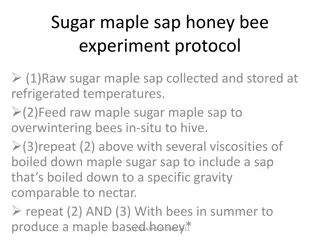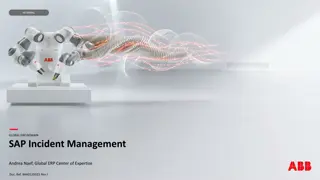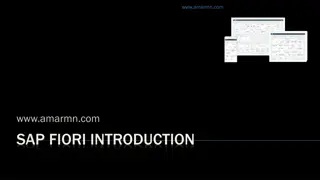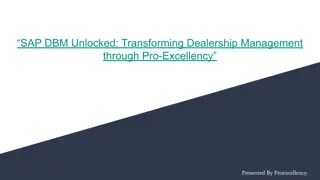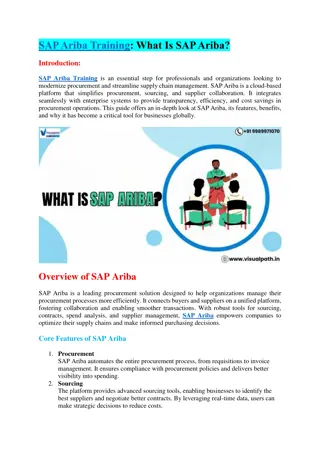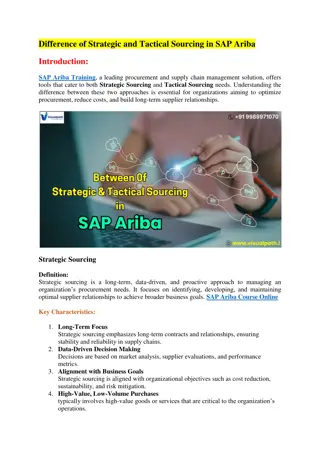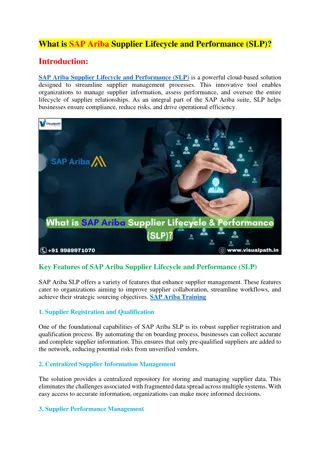
Effective SAP ERP Best Practices for Production Planning and Supply Chain Management
Discover the best practices in SAP ERP for production planning, logistics, financial management, and supply chain management. Explore topics such as system configuration, master data management, manufacturing processes, and more. Gain insights into creating material master records, bills of material, work centers, task lists, and advanced BOM functions. Enhance your knowledge of SAP navigation, applications, components, and terminology for efficient business operations.
Download Presentation

Please find below an Image/Link to download the presentation.
The content on the website is provided AS IS for your information and personal use only. It may not be sold, licensed, or shared on other websites without obtaining consent from the author. If you encounter any issues during the download, it is possible that the publisher has removed the file from their server.
You are allowed to download the files provided on this website for personal or commercial use, subject to the condition that they are used lawfully. All files are the property of their respective owners.
The content on the website is provided AS IS for your information and personal use only. It may not be sold, licensed, or shared on other websites without obtaining consent from the author.
E N D
Presentation Transcript
I. SAP 1. (Production Planning) . SAP ERP Best Practice . 2. Step2_ Step1_ - : ERP - : - : 200 - : 100 - : ERP + - : + ERP (40H) : (ERP) : (Logistics) (Financial) (50H) : (25H) (25H) : : ,SCM (160H) : Master Data , , * 2
II. 1. ERP 1. (ERP) - SAP , Applications, Components, Terminology Classroom 5 ( 40 ) (SAP ) (Logistics) (Financial) ERP (Logistics) (Financial) 3
II. 1. ERP 2. ERP SAP Navigation ERP SAP 1 , , , 2 2 (Logistics) , 3 , , , - 4
II. 1. ERP 2. ( ) (Logistics) , 4 (Financial) 5 , 5
II. 2. Supply Chain Management Manufacturing 1. Master Data , , SAP ERP Best Practice Classroom 20 ( 160 ) / System Configuration Basic Data Production Planning Production Orders Introduction to Production Execution Production with Process Orders Repetitive Manufacturing 6
II. 2. Supply Chain Management Manufacturing 2. _1 Overview of Master Data for Production Accessing and Creating Types of Data Using Organizational Elements and Master Data in Production Organizational Data in Supply Chain Management Creating a Plant in SAP ERP Creating a Storage Location in SAP ERP Creating MRP Areas Material Masters Describing the Structure of the Material Master Record Maintaining Prerequisites for Creating Material Masters Creating a Material Master Record Classifying Material Master Records Managing the Material Master 1 Basic Data Bills of Material (BOMs) Describing the Structure of the Bill of Material Managing the Validity of BOMs Managing Bills of Material Using ECM to Change BOMs 2 - 7
II. 2. Supply Chain Management Manufacturing 2. _1 ( ) Analyzing Bills of Material Configuring Bills of Material Modeling the Manufacturing Process Describing the Structure of Master Data Creating Work Centers Modeling the Manufacturing Process Creating Capacities in the Work Center Integrating Costing with the Work Center 2 Basic Data Task Lists Describing the Structure of the Task List Creating Material Assignments and Component Allocations Creating Suboperations and User-Defined Fields Analyzing and Changing Task Lists Advanced Bill of Material Functions Describing Phantom Assemblies Creating Co-Products and By-Products Creating Alternative Components Creating Multiple BOMs 3 8
II. 2. Supply Chain Management Manufacturing 2. _1 ( ) Advanced Bill of Material Functions Creating Variant BOMs Using Mass Change and the Product Structure Browser Advanced Routing Functions Modeling Complex and Flexible Manufacturing Modeling Alternative Manufacturing Processes Creating Reference Operation Sets Using Lead-Time Scheduling to Update the Material Master Scheduling Time Elements and Reduction in the Routing 4 Basic Data Advanced Routing Functions Creating Trigger Points Using Scrap in the Routing Creating Production Resources and Tools Alternative User Interfaces Describing the Structure of the Engineering Workbench Setting the Work Area, Selection Criteria, and Effectivity Window Navigating in the Engineering Workbench 5 9
II. 2. Supply Chain Management Manufacturing 2. _1 ( ) Creating Engineering Workbench Work Areas Using the PLM Web User Interface Using Status and Action Management Synchronizing BOMs using Guided Structure Synchronization Tracking Changes in BOMs Using Redlining Basic Data 5 10
II. 2. Supply Chain Management Manufacturing 2. _2 Overview of Production Planning in SAP ERP Outlining the Supply Chain Planning Process Outlining the Core Production Planning Process Demand Management Introducing Demand Management Planning Make-to-Stock Production Without Consumption Logic 6 Demand Management Planning Make-to-Stock Production with Consumption Logic Planning Make-to-Order Production Without Consumption Logic Planning Make-to-Order Production with Consumption Logic Assembly Processing in Make-to-Order Production Applying Demand Management Enhancements Analyzing Availability Check Basics Material Requirements Planning Execution Outlining the Basic Concept of Material Requirements Planning Setting up the MRP Prerequisites Executing the MRP Run Production Planning 7 - 11
II. 2. Supply Chain Management Manufacturing 2. _2 ( ) Material Requirements Planning Execution Setting up the MRP Run Planning MRP Interactively Firming Planned Orders Technical Processes of Requirements Planning Calculating Net Requirements Technical Processes of Requirements Planning Buffering Net Requirements Calculation 8 Production Planning Technical Processes of Requirements Planning Calculating Lot Sizes Selecting Procurement Types Setting Up Basic-Date Scheduling Setting up Lead-Time Scheduling Selecting BOM and Routing MRP Results Processing and Evaluations Comparing MRP List and Stock/Requirements List 9 12
II. 2. Supply Chain Management Manufacturing 2. _2 ( ) MRP Results Processing and Evaluations Applying the Planning Table Identifying Exception Messages Applying Additional Evaluation Aids Additional MRP Processes Applying Master Production Scheduling Setting up Long-Term Planning Executing Long-Term Planning Analyzing Multi-Site Planning MRP Areas Setup Applying MRP Areas Production Planning 10 13
II. 2. Supply Chain Management Manufacturing 2. _3 Introduction to Production Orders Outlining SAP Supply Chain Management Characterizing Production Orders Embed Production Orders in Supply Chain Management Order Processing and Order Structure Processing Production Orders Analyzing the Production Order Structure 11 Order Creation Creating Production Orders Without Master Data Creating Production Orders Based on Planned Orders Creating Production Orders Without Planned Orders Defining Order Types Creating Production Orders with Master Data Scheduling of Production Orders Costing of Production Orders Production Orders 12 Order Release Checking Material Availability Checking Capacity Availability 13 14
II. 2. Supply Chain Management Manufacturing 2. _3 ( ) Checking PRT Availability Planning Capacities Releasing Production Orders 13 Order Documents Printing Production Orders Material Staging Staging Material Withdrawing Material Confirmations Parameterizing Confirmations Executing Confirmations 14 Production Orders Goods Receipt Enabling Goods Receipts Posting Goods Receipts Order Settlement, Archiving and Deletion Settling Production Orders Archiving and Deleting 15 15
II. 2. Supply Chain Management Manufacturing 2. _3 ( ) Information Systems and Automation Applying Information Systems Automating and Mass Processing Applying Collective Orders Applying Trigger Points Further Functions and Enhancements Applying Order Split Applying Shift Reports and Shift Notes Applying Work-in-Process (WIP) Batches Applying SAP Execution Steps (XSteps) for Routings and Production Orders Outlining the Production Planning Plant Data Collection (PP-PDC) Interface Outlining SAP Manufacturing Integration and Intelligence (SAP MII) in Shop Floor Control Applying Handling Units in Production Production Orders 15 16
II. 2. Supply Chain Management Manufacturing 2. _4 Introduction to Production Execution Distinguishing Production Types Production with Process Orders Drafting Process Orders Creating and Interpreting Process Orders Executing Process Orders Using Additional Functions with Process Orders PP-PI 16 Repetitive Manufacturing Drafting Repetitive Manufacturing Preparing Repetitive Manufacturing Planning Line Loading in Repetitive Manufacturing Using Material Staging and Confirmation Integrating Costing, Controlling, and Reporting REM 17 The Kanban Principle Drafting Kanban Using Kanban in Production KANBAN 18 17
II. 2. Supply Chain Management Manufacturing 2. _4 ( ) Capacity Requirements Planning (ERP) Introducing Capacity Requirements Planning Evaluating Capacity Leveling Capacity in the Tabular Planning Table 18 CRP Capacity Requirements Planning (ERP) Maintaining Available Capacity Capacity Requirements Planning (ERP) Leveling Capacity in the Graphical Planning Table Evaluating Capacity Using Business Intelligence 19 Review Certification Review 20 18

